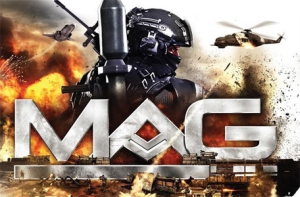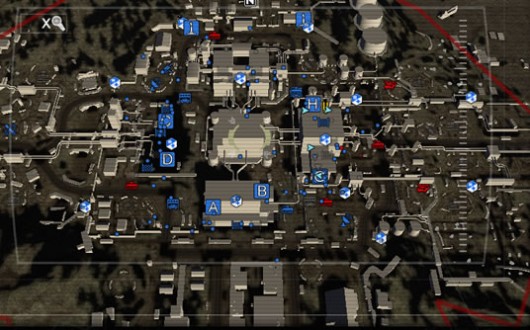 When MAG was first announced at E3 2008, it immediately became one of my most-watched games. I was delighted at PAX Prime 2009 to play it with some of the guys at Zipper Interactive at a PlayStation Blog meetup, and redeemed the beta vouchers from the expo as soon as I could. Participating in nearly all of the betas, I was extremely excited to take it home launch day and sink my teeth into everything the final product had to offer. A year later I only touch the game every now and then, and this is as much the community’s fault as it is Zipper’s. MAG was an incredibly ambitious project which really nailed all the key areas it needed to hit, but in many ways that same ambition led to the problems responsible for its diminished player base. The game is an interesting example of innovation as well as the shortcomings of a good idea, and we’re looking back at these issues in the inaugural edition of The G-Spot.
When MAG was first announced at E3 2008, it immediately became one of my most-watched games. I was delighted at PAX Prime 2009 to play it with some of the guys at Zipper Interactive at a PlayStation Blog meetup, and redeemed the beta vouchers from the expo as soon as I could. Participating in nearly all of the betas, I was extremely excited to take it home launch day and sink my teeth into everything the final product had to offer. A year later I only touch the game every now and then, and this is as much the community’s fault as it is Zipper’s. MAG was an incredibly ambitious project which really nailed all the key areas it needed to hit, but in many ways that same ambition led to the problems responsible for its diminished player base. The game is an interesting example of innovation as well as the shortcomings of a good idea, and we’re looking back at these issues in the inaugural edition of The G-Spot.
MAG is not the first shooter envisioning matches on a massive scale. Sony’s own PlanetSide boasted far greater numbers in a truly MMOFPS. Many PC players have also tested the bandwidth of their dedicated servers, hosting games with hundreds of players, usually to an obliterated frame rate. MAG differentiated itself from these past attempts at pushing the limit of the FPS player-count, as well as the grandfather of large-scale FPS skirmishes, the Battlefield series, by delivering the key element a shooter that massive would need: a command structure.
The genius of MAG is the way it interweaves the intimate 8-on-8 moments typically found on console shooters with the chaos of large confrontations. The instrument manipulating this tempo is the command structure. Each player is matched into a squad of up to eight, with one player designated as Squad Leader to choose objectives and utilize commands. Four squads are lumped together into a single platoon, which typically only sees one major section of a map; in 256-player games, four platoons form a single company. The company commander (Officer-in-Charge) and Platoon Leaders gain game changing abilities and a dedicated headset channel. Unfortunately, without being able to select objectives themselves, these players never ended up coordinating the individual squads, nor ideally controlling every soldier. Here is where MAG’s problems began to surface.

If you survive the last paragraph’s gameplay explanation you can probably tell that the command structure is where MAG would make or break as a game that huge without it devolving into unfocused mayhem. The command structure was the first casualty of the game, hindering it from playing how it was intended. First of all, everything I explained is vaguely described in the manual, but it is never actually explained in-game (there is a general tutorial on how to move, drive, shoot, and place explosives, but that’s about it). While Zipper released a series of tutorial videos on the PlayStation Blog and Store, the closest thing to a comprehensive guide remotely affiliated with Zipper came from Thagmor in the community forums, which makes for interesting reading if nothing else (as well as an expose into fan dedication). As such, most players are never introduced to anything explaining how that command structure works. If they were, they simply don’t care. At least from my experience in MAG, effective Squad Leaders are the exception and not the rule, and higher officers who take a role in micromanaging via headset are practically nonexistent. This problem would only be compounded by the inevitable stream of glitches and bugs.
Any software product is obviously subject to bugs, and gamers know this better than anyone. With a game involving a near unprecedented amount of players on massive battlefields with tons of in-game parameters, not to mention the nightmare a matchmaking system must have been, there are bound to be a plethora of issues. But one issue that is almost inexcusable is mic support. As of today, microphone functionality is still one of the known issues the team is investigating. Many times during play my team would be screaming at me to use command abilities (“OH MY GOD, WHAT ARE YOU DOING???”), and I could not respond to tell them about the cool-down times because my mic was not working. I’ve used multiple mics on different PS3’s and even signed in to different PSN accounts and this problem pervaded with all of them. In a game that stands to be one of the most tactical shooters ever made, this is easily one of the greatest disappointments I’ve had with the game. Mic problems are far from the only issues in the game, as connection errors, freezing, and geometry issues have all showed their faces at least once since launch.
With a game this big, accommodating so many players, a certain compromise in visual fidelity is expected along with bugs. I personally found the quality of the graphics to be satisfactory for the game it was, but many did not. I’ve met tons of players, particularly during the betas, who complained of the graphics and used it as an excuse to go back to Call of Duty. While my friends and I who were entranced by the game thought of this as rather shallow, I still had to acknowledge the game was not beautiful. It wasn’t just the graphics themselves, either. The animations were also disappointing. When the game shipped, there was no animation for aiming down the sights, you simply were looking through your guns’ sights after holding L1. Indeed, the character movement is rather simplistic, and looking around with the right stick always felt a little off. I can’t quite put into words what felt wrong with it, but the game is nowhere near as smooth as many of its more lauded contemporaries are.
However, updates to the graphics engine, particularly with lighting, were one of the first updates to come out – in fact, the patch released the day the game launched. If there’s one thing Zipper’s proven over the course of MAG’s ongoing post-launch development, it’s that they are undoubtedly one of the most dedicated teams in the industry when it comes to their fans. For every complaint about bugs or balancing (and believe me, balancing is probably the most frustrating part of the game to the community), the team has shown through forum participation that they’re there to listen, and that level of understanding produced one of the most reliable streams of updates I’ve seen for an online shooter. Community manager Jeremy Dunham impresses many with his sympathy and active commitment to talking to the fans and serving as an intermediary with the studio. When he brought over Chris Roper, also an IGN-expatriate (Podcast Beyond has never been the same), the two put a real face on the studio with their consistent Zipline podcast and real blog presence. Every episode they bring on a member of the team to talk about their history with the company and what their plans are for MAG, and they keep you in the loop (as much as they legally can) on where MAG comes from and where it’s going. They convey a sense of honesty when they say that, despite the development of the highly anticipated SOCOM 4, MAG is an ongoing live project at Zipper, and it’ll be a very different game a year after its launch.

Chris Roper (left) and Jeremy Dunham (right)
And indeed it is. The game has had its entire customization and loadout system overhauled to keep things fresh in a patch that also incorporated an even bigger development – PlayStation Move support. As part of Sony’s initiative to prove its motion controller has relevance to hardcore gamers, MAG competently integrated the controller into its game. While platforming from crate to crate to trailer in order to get that sweet sniping spot requires patience, it’s impressive just how well the motion controls work. On the day the patch came out, I returned to try out the game with the Move and its entirely new progression system. Even though I was playing on the same maps with similar weapons and familiar mechanics, it felt like a surprisingly fresh experience. That experience reinforced in my mind that no matter how big some oversights may seem, MAG is a special place where interesting things happen.
The PlayStation 3 is certainly a console home to many ambitious titles that fail. Despite some serious disappointments, I would still regardless put MAG with the category that managed to pull off something pretty impressive from their good idea. At $30 new, about $25 used, and available for digital download from the PlayStation Store, any shooter enthusiast with a PS3 owes this game a look. A few feats are nothing short of remarkable. Some of the best map design I’ve seen in an FPS oozes from every corner of Zipper’s sprawling battlefields. The deep cache of weapons, equipment, and abilities make for nearly limitless combinations in a relatively balanced system. But most impressive is the fact that they did all of these things while creating a 256-player game that actually works.
– G
The G-Spot is Staff Writer Mike Gutierrez’s own little corner of Warp Zoned where you can find his rants on issues affecting gaming in general or at specific games. We would say his views don’t necessarily reflect those of Warp Zoned, but we don’t want to hurt his feelings.







